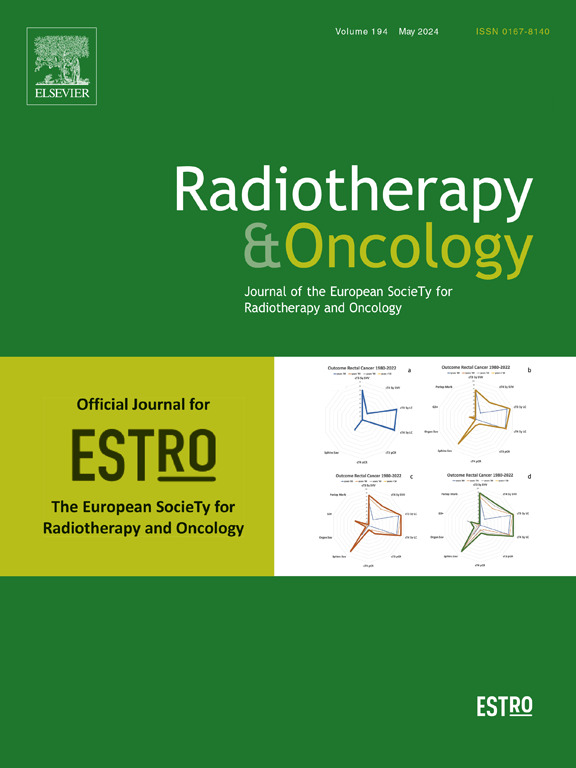骨转移与非骨病变对姑息性放疗的疼痛反应:前瞻性研究
IF 4.9
1区 医学
Q1 ONCOLOGY
引用次数: 0
摘要
背景这项研究根据姑息性放疗有效性国际共识(ICPRE)标准,比较了骨转移姑息性放疗和非骨转移姑息性放疗的疼痛反应。在预设的 2、4、12、24、36 和 52 周时间内,使用 ICPRE 标准对疼痛反应进行评估。主要结果是 12 周内的疼痛反应率,对两组骨质和非骨质病变患者进行比较。结果在符合标准的440名患者的678个病灶中,541个(80%)和137个(20%)属于骨和非骨病灶组,包括原发肿瘤、淋巴结转移和其他。平均年龄为 63 岁,45% 为女性。治疗方法包括单次 8 Gy 剂量、5 次 20 Gy 剂量和 10 次 30 Gy 剂量的常规放疗,用于 89% 的病变。虽然不同组群的阿片类药物使用率(67%)和再次照射率(22%)没有差异,但非骨癌组群的中位生存期更短(4.9 个月对 6.3 个月,P = 0.017),分次照射更频繁(85% 对 67%,P <0.001)。两组患者的疼痛反应率没有差异(57% 对 62%,P = 0.33),调整协变量后仍保持一致。再次照射和阿片类药物对骨队列的疼痛反应有负面影响。结论这项研究表明,姑息放射治疗对疼痛的非骨病变有效,但对疼痛反应有潜在的剂量依赖性,这突出表明未来需要进行随机对照试验,以确定最佳放射剂量。本文章由计算机程序翻译,如有差异,请以英文原文为准。
Pain response to palliative radiotherapy in bone metastases vs. non-bone lesions: Prospective study
Background
This study compared the pain response to palliative radiotherapy for bone metastases and non-bone lesions based on the International Consensus on Palliative Radiotherapy Effectiveness (ICPRE) criteria.
Methods
This two-cohort study used data from a prospective cohort of 867 registered lesions from 500 patients conducted between August 2021 and September 2023. Pain responses were assessed using the ICPRE criteria at prespecified timings of 2, 4, 12, 24, 36, and 52 weeks. The primary outcome was the pain response rate within 12 weeks, comparing two groups of patients with bone and non-bone lesions. A multivariate logistic regression analysis was conducted to adjust for confounding covariates based on opioid use, irradiation history, performance status, NRS, primary disease, and radiation dose.
Results
Among 678 lesions from 440 patients who met the criteria, 541 (80 %) and 137 (20 %) were in the bone and non-bone cohort, including primary tumors, lymph node metastases, and others. The mean age was 63 years, and 45 % were female. Treatment included conventional radiotherapy of a single 8 Gy dose, 20 Gy in 5 fractions, and 30 Gy in 10 fractions, used in 89 % of lesions. While opioid use (67 %) and re-irradiation rates (22 %) were not different between cohorts, the non-bone cohort had shorter median survival (4.9 months vs. 6.3 months, P = 0.017) and more frequently fractionated irradiation (85 % vs. 67 %, P < 0.001). No differences were observed in pain response rates between the two groups (57 % vs. 62 %, P = 0.33), which remained consistent after adjusting covariates. Re-irradiation and opioid were associated with negative impacts on pain response in the bone cohort. In contrast, the increased irradiation dose was identified as potentially affecting the non-bone cohort.
Conclusions
This study suggested palliative radiotherapy is effective for painful non-bone lesions and potential dose-dependency for pain response, highlighting the need for future randomized controlled trials to determine the optimal radiation dose.
求助全文
通过发布文献求助,成功后即可免费获取论文全文。
去求助
来源期刊

Radiotherapy and Oncology
医学-核医学
CiteScore
10.30
自引率
10.50%
发文量
2445
审稿时长
45 days
期刊介绍:
Radiotherapy and Oncology publishes papers describing original research as well as review articles. It covers areas of interest relating to radiation oncology. This includes: clinical radiotherapy, combined modality treatment, translational studies, epidemiological outcomes, imaging, dosimetry, and radiation therapy planning, experimental work in radiobiology, chemobiology, hyperthermia and tumour biology, as well as data science in radiation oncology and physics aspects relevant to oncology.Papers on more general aspects of interest to the radiation oncologist including chemotherapy, surgery and immunology are also published.
 求助内容:
求助内容: 应助结果提醒方式:
应助结果提醒方式:


